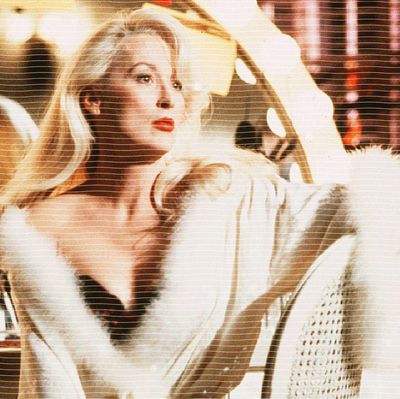

A series investigating the effects of gravity on the female form.
Death Becomes Her is filled with campy special effects, but the film’s most mesmerizing ones don’t involve twisting heads or holes being blasted through torsos. Its most truly special effects are those in a scene in which Meryl Streep undergoes something of a rapid full-body makeover. After drinking a magical potion from a nearly nude Isabella Rossellini who may or may not be the devil, Streep gazes ecstatically in a mirror as her skin smooths, her hair thickens, her butt cheeks tighten, and her breasts lift — bam and bam — to buoyant new heights. “I’m a GIRL!!!” her character exclaims, minor chords crescendoing in the background.
The scene is arguably the climax of Robert Zemeckis’s 1992 film — its exuberant high, and the moment after which all hell (literally) breaks loose. As a child, I was fascinated by the film, and that scene in particular. I watched, rapt, as Streep reverse ages — then, after a series of very unfortunate events, transforms into a repulsive caricature of herself; Rossellini’s magic basically leaves her looking like every woman’s plastic-surgery nightmare. Now, decades later, as I head into my mid-30s, I find these horrific consequences are guiding my real-life choices about aging in surprisingly productive ways. The movie got inside my head, and I like it there.
For the uninitiated, Death Becomes Her, which turns 25 this year, is a dark comedy about two frenemies — the fading actress Madeline Ashton (Meryl Streep) and the fragile writer Helen Sharp (Goldie Hawn) — whose obsessions with beauty, youth, and a schlubby plastic surgeon played by Bruce Willis drive them to murderous extremes. They also drive them to make a deal with Rossellini’s sorceress, who grants them eternal youth in exchange for their mortal freedom. (Think Benjamin Button meets Hocus Pocus.) While the movie debuted to mixed reviews — the New York Times called it “wildly uneven” and The New Yorker called the narrative invention “pitiful” — in the years since, it’s risen to cult status. Last year, Scream Factory released it for the first time on Blu-ray, marketing it alongside thrillers like The Thing and Halloween II. But characterizing it as merely a horror flick, even a satirical one, misses its real legacy — at its core, the movie is a 105-minute PSA against trying to turn back the clock on our bodies, and it’s more relevant now than ever.
When Death Becomes Her premiered, as with Billy Wilder’s Sunset Boulevard before it, reviewers described it as a film that captured the pressure women feel to appear eternally young in Hollywood. Last year, Streep upped the ante, commenting that “it’s sort of a documentary on aging in Los Angeles now.” The film was prescient, sounding an alarm years before the rise of reality-TV shows that glorified excessive plastic surgery, from Dr. 90210 to The Swan (remember that fright fest?) to the entire Real Housewives franchise. Today, it captures the pressure nearly all women feel to cling to our youth as tightly as Helen Sharp clings to her bloody stress rags. In our optics-obsessed culture, every woman is the star of her own social-media feeds, and we’re all at risk of becoming Madeline Ashton, of fixating on our perceived flaws to the point of self-destruction.
Once we develop fixations, we don’t need to seek out a nude Isabella Rossellini to indulge our insecurities. Since the film’s release, the so-called “anti-aging” industry has exploded. In 2015, Americans spent more than $13.5 billion on aesthetic procedures, according to a report from the American Society for Aesthetic Plastic Surgery. While not all of these procedures are specifically intended to turn back time, four of the top five nonsurgical procedures that year — Botox, hyaluronic-acid injections, chemical peels, and microdermabrasion — qualify as anti-aging treatments. “Our industry’s growth is considerable, but not at all surprising,” the society’s then-president, Dr. James C. Grotting, said in a press release. “Youth is a commodity, and people are investing in themselves to maintain a younger, healthier appearance.”
Death Becomes Her came out when I was 11 years old and had just begun to pay close attention to women’s relationships with their bodies — and I studied how ecstatic, and empowered, a wrinkle-free face made Streep’s character. Now, at 35, I find myself staring in the mirror each morning, pondering whether the fine lines on my forehead have always been there or did they appear in my sleep? Did my eyes always scrunch up like that when I smile or am I already a few years too late with the retinol? Confronting one’s mortality can be terrifying. It can make you want to run screaming to the dermatologist.
But so far, something has stopped me. For now, every time I’m tempted to tamper with the “natural laws” (as the movie calls them, sternly) governing my appearance, I’m haunted by the specter of Madeline Ashton — her melting face, her shattered body, her desperate attempts to, quite literally, “preserve” a younger version of herself. (Spoiler alert: Once she drinks the magical potion, Madeline becomes immortal — but after she’s pushed down a flight of stairs, she becomes a dead woman walking and her body deteriorates.) I picture the formaldehyde and spray paint Bruce Willis uses on her to create the illusion of vigor. And I take a deep breath and proceed with caution.
Death Becomes Her is a cartoonish warning, an over-the-top parable about letting fear get the better of us. But for me, it’s provided an effective yield sign. The Disney princess movies I devoured as a kid sent the message that beauty is a value to be prized, but Zemeckis’s film provided an antidote — suggesting prizing beauty above all else comes at a cost. A dripping, oozing, grotesque, maybe even eternal cost.
Since the film’s release, Streep and Hawn have, of course, aged in real life, too, offering a fascinating opportunity to compare a macabre fantasy of growing older to reality. Streep, now 67 years old, has become a poster child for “aging gracefully.” (Literally. Google the phrase, and an image of the actress is the first one that pops up.) And she continues to earn the respect of peers and audiences, not because of the tautness of her skin, but because of the force and depth and seeming authenticity of her personality.
Maybe starring in Death Becomes Her ingrained in Streep a belief that eternal youth can’t be swallowed, or bought. Maybe not. Either way, Streep today provides nearly as powerful a case for being gentle with our aging bodies as her character did 25 years ago. As Viola Davis told the actress at the Golden Globes last month, while presenting her with a lifetime achievement award, “You make me feel that what I have in me — my body, my face, my age — is enough.” Twenty-five years later, Death Becomes Her makes me feel the same. For now.




